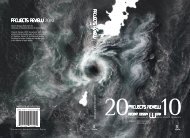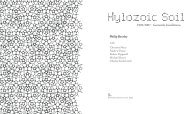The Inner Studio - Riverside Architectural Press
The Inner Studio - Riverside Architectural Press
The Inner Studio - Riverside Architectural Press
You also want an ePaper? Increase the reach of your titles
YUMPU automatically turns print PDFs into web optimized ePapers that Google loves.
THE INNER STUDIO<br />
you will find that it is possible and effortless to bring these two activities<br />
together. If you are experienced, you can begin directly with the project<br />
you are working on. Beginners may want to practice visualizing a favorite<br />
place, a place that has a healing quality, or a safe place that you really<br />
find peaceful. It may be your secret sanctuary in the city or the forest, it<br />
may be on a beach or in a special room.<br />
Close your eyes and begin by thinking about the place and watching<br />
for an image in your mind’s eye. You may think of one thing, but the<br />
image that arises may be different. Try experimenting with different<br />
internal directions to get a feeling for the kinds of inner directions that<br />
are most effective for you. Direct the visualization to follow what you are<br />
curious about. If you enjoy the way light is falling into the space you are<br />
imagining, make an image of that phenomenon. <strong>The</strong>se drawings are<br />
copies of what we see in the mind’s eye. <strong>The</strong> drawing may depart from<br />
the visualization, just as the visualization may have departed from your<br />
first image. Go with your creative instincts and follow the images inspired<br />
by your imagination. It is really impossible to draw anything without first<br />
seeing this image or having a felt sense of it. In fact, it probably isn’t<br />
helpful to draw at all if no images are forthcoming. Some people enjoy<br />
the act of drawing and create this way, but behind the movement of the<br />
pen, mental images are guiding what appears on the page.<br />
It’s helpful to get the feel of playing with images in your mind’s eye<br />
to shift your attention to the images and pictures in your mind. It’s a<br />
process whereby you allow images to float and move through your<br />
mind’s eye as if you were watching a school of fish swim by. If you see<br />
something that moves you, you might choose to look at it more closely.<br />
When you feel yourself losing interest in an image and your concentration<br />
wavers, let it go–whether it is a drawing or an internal image. <strong>The</strong><br />
beginning stage is not the time to fight through. Instead, return to the<br />
intention of the exercise you began with.<br />
We want to take advantage of internal states of imagination, which<br />
are free of many of the worldly restrictions a design project will eventually<br />
encounter. With your eyes slightly closed, there are no problems with<br />
budget, there are no physical constraints of the site–you are completely<br />
free to tune into your imagination. This approach acknowledges that we<br />
usually draw what we have already visualized, but the process may occur<br />
so quickly that we are not aware of the step of visualizing. Now we want<br />
116





